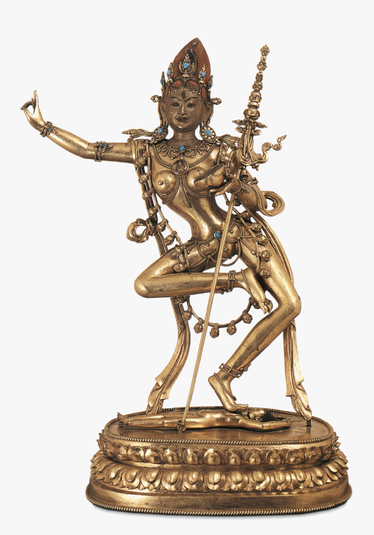
Item: Vajrayogini (Buddhist Deity) - Vajravarahi, Red
| Origin Location | Mongolia |
|---|---|
| Date Range | 1700 - 1799 |
| Lineages | Gelug and Buddhist |
| Size | 38.40cm (15.12in) high |
| Material | Metal, Mercuric Gild, Painted Face/Hair, Stone Inset: Turquoise |
| Collection | Private |
Classification: Deity
Appearance: Semi-Peaceful
Gender: Female
Vajrayogini, Vajravarahi: behind the central crown ornament is the head of a sow.
It can be difficult to identify images of Vajravarahi in sculpture and to distinguish Vajrayogini from Vajra Nairatmya. Vajrayogini, of the Chakrasamvara cycle of Tantras, has many different forms. In her yogini aspect she does not have a sow face. In her varahi aspect she has a sow face. Vajrayogini is the name of the larger category of deity and Vajra Varahi is a class of deity within the larger Vajrayogini classification. The essential characteristic in naming this sculpture as Varahi is to identify a small sows face/head on either the top of Yogini's head or to the proper right side of her face. If there is no sows head/face then this sculpture is positively not portraying Vajra Varahi. The varaha/i face is the singular defining characteristic for Varahi.
Lacking an identification of Vajravarahi then the image could be either Vajrayogini, or Vajra Nairartmya of the Hevajra Tantra. Iconographically the visual difference between Vajrayogini and Vajra Nairatmya is colour, the body colour. Yogini is typically red and Nairatmya is typically blue. With sculpture it can be impossible to distinguish between the two female figures because, lacking a colour, because all of their hand attributes, adornments and postures are identical.
When confronted with this type of problem then the popularity of a subject might be considered. Vajrayogini is much more popular as an art work for ritual or gift exchange and Nairatmya less popular. Based on popularity it is then more likely that such figures as this would be Vajrayogini although not conclusive.
"Vajra Nairatma, [with] a body black in colour, one face and two hands. The right [hand] holds aloft a curved knife and the left a skullcup to the heart, and carrying a katvanga [in the bend of] the elbow. Having three eyes and bared fangs. Yellow hair bristling upwards. A crown of five dry human skulls and a necklace of fifty. Adorned with the five ornaments of bone. Wearing a lower garment of tiger skin. Standing on a corpse seat in a dancing manner with the left leg extended in a half [vajrasana] posture." (Konchog Lhundrub, 1497-1557).
[77] Vajravarahi (Bari Gyatsa): "Vajravarahi, with a body red in colour, one face and two hands. The right [hand] holds, in a manner held aloft, a vajra curved knife. The left holds to the heart a blood filled skullcup and carrying a katvanga [in the bend of] the elbow. Having three eyes and bared fangs. Having a crown of five dry human skulls and a necklace of fifty fresh. Adorned with a garland of flowers. Wearing a lower garment of tiger skin. Standing in a dancing manner with the left leg extended in a half [vajrasana] posture."
Jeff Watt 5-2019
Subject: Masterworks Main Page (大师之作主页, ཕུལ་བྱུང་གི་སྒྱུ་རྩལ་ཁག།)
Thematic Sets
Region: Mongolia, School of Zanabazar (Masterworks)
Sculpture: Zanabazar Style (Peaceful Appearance)
Buddhist Deity: Vajrayogini, Varahi (Sculpture Masterworks)
Buddhist Deity: Vajrayogini, Varahi (Comparison)
Buddhist Deity: Vajrayogini, Vajravarahi Study Guide (Brief)
Buddhist Deity: Vajrayogini Iconography/Index of Names
Sculpture: Zanabazar Style Art History
Subject: Layered Deities & Figures
Subject: Masterworks (Iconography, 图像学)
Subject: Art Evaluation Criteria (Sculpture)
Buddhist Deity: Vajrayogini, Vajravarahi Iconography
Buddhist Deity: Vajrayogini, Vajravarahi Main Page
Buddhist Deity: Vajrayogini, Varahi (top of the head)
Buddhist Deity: Vajrayogini (Masterworks)
Subject: Gauri, Yogini, Nairatmya
Exhibition: Mandalas, Mapping the Buddhist Art of Tibet (Sculpture)
Exhibition: Mandalas, Mapping the Buddhist Art of Tibet (Corrigendum)
Sculpture: Zanabazar Style (Mongolia)
